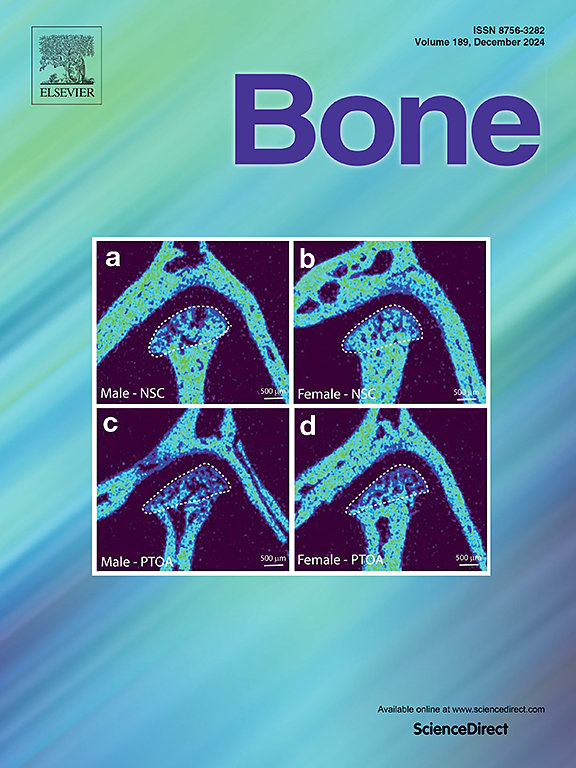Craniosynostosis among children with X-linked hypophosphatemia: A systematic review and meta-analysis
IF 3.6
2区 医学
Q2 ENDOCRINOLOGY & METABOLISM
引用次数: 0
Abstract
Background
X-linked hypophosphatemia (XLH) is a rare genetic disorder caused by PHEX gene variants, leading to elevated FGF23 levels and impaired phosphate reabsorption, resulting in abnormal bone growth. Skull abnormalities, including craniosynostosis, are often reported in children with XLH, but the true prevalence of craniosynostosis among children with XLH is unknown.
Methods
We performed a systematic review and meta-analysis to estimate craniosynostosis prevalence in children with XLH. We searched PubMed, Embase, and Web of Science for cohort studies or large case series published before June 2024. Eligible studies included at least ten children with XLH and reported craniosynostosis prevalence without selection based on skull abnormalities. Pooled prevalence was calculated using a random-effects model, with heterogeneity assessed.
Results
Of 517 studies initially identified, ten studies with 461 patients met the criteria for inclusion. The pooled prevalence of craniosynostosis among children with XLH was 22 % (95 % confidence interval (CI) 9.0 % to 44 %) with significant heterogeneity across studies (I2 = 88.5 %, p < 0.01). This prevalence is far greater than the prevalence of craniosynostosis in the general pediatric population, which is estimated to be one in 2100–2500 births. We confirmed an expected female predominance among children with XLH (median 65.9 % female, interquartile range [IQR] 53.7 % to 68.4 %) but not among children with XLH and craniosynostosis (median 42 % female, range 21 % to 48 %).
Conclusion
Craniosynostosis is more common among children with XLH compared to the general pediatric population and may be disproportionately common among males. Increased vigilance for craniosynostosis is warranted for children with XLH.
x连锁低磷血症儿童颅缝闭闭:一项系统回顾和荟萃分析
x连锁低磷血症(XLH)是一种罕见的遗传性疾病,由PHEX基因变异引起,导致FGF23水平升高和磷酸盐重吸收受损,导致骨生长异常。颅骨异常,包括颅缝闭锁,经常在XLH儿童中报道,但XLH儿童颅缝闭锁的真实患病率尚不清楚。方法:我们进行了一项系统回顾和荟萃分析,以估计XLH儿童颅缝闭锁的患病率。我们检索了PubMed、Embase和Web of Science,检索了2024年6月之前发表的队列研究或大型病例系列。符合条件的研究包括至少10名患有XLH的儿童,报告了颅缝闭锁的患病率,而没有根据颅骨异常进行选择。使用随机效应模型计算合并患病率,并评估异质性。结果在最初确定的517项研究中,有10项研究461例患者符合纳入标准。XLH患儿颅缝闭合的总患病率为22%(95%可信区间(CI) 9.0% ~ 44%),各研究间存在显著异质性(I2 = 88.5%, p <;0.01)。这一患病率远远高于普通儿科人群中颅缝闭闭的患病率,后者估计为2100-2500例新生儿中有一例。我们证实了女性在XLH患儿中的预期优势(中位数为65.9%女性,四分位数范围[IQR] 53.7%至68.4%),但在XLH合并颅缝闭塞的患儿中并非如此(中位数为42%女性,范围为21%至48%)。结论与普通儿科人群相比,XLH患儿颅缝闭锁更为常见,且在男性中可能不成比例。对于患有XLH的儿童,提高对颅缝闭合的警惕是有必要的。
本文章由计算机程序翻译,如有差异,请以英文原文为准。
求助全文
约1分钟内获得全文
求助全文
来源期刊

Bone
医学-内分泌学与代谢
CiteScore
8.90
自引率
4.90%
发文量
264
审稿时长
30 days
期刊介绍:
BONE is an interdisciplinary forum for the rapid publication of original articles and reviews on basic, translational, and clinical aspects of bone and mineral metabolism. The Journal also encourages submissions related to interactions of bone with other organ systems, including cartilage, endocrine, muscle, fat, neural, vascular, gastrointestinal, hematopoietic, and immune systems. Particular attention is placed on the application of experimental studies to clinical practice.
 求助内容:
求助内容: 应助结果提醒方式:
应助结果提醒方式:


